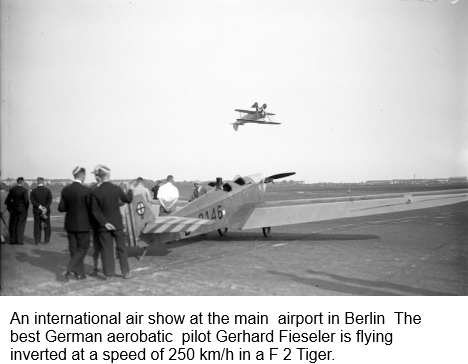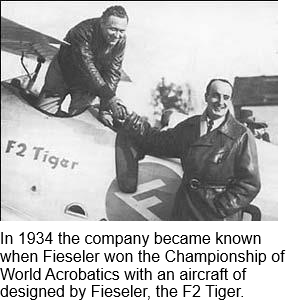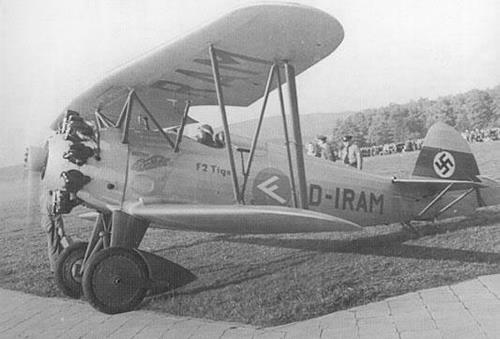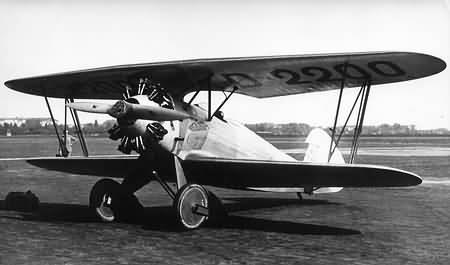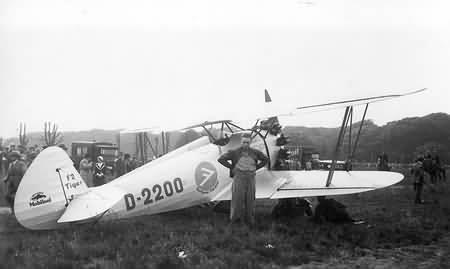Gerhard Fieseler was one of the best paid aerobatics pilots of the world in the end of the twenties and beginning of the thirties. With the incomes he could finance his own company. In order to remain competitive, Fieseler must have a new machine with still better prestanda than those of the F1 "Tigerschwalbe". Fieseler saw no future in the building of gliders for its enterprise and began in 1931 with this project building of powered aircrafts. Fieselers experiences with the F 1 was used by the technical designer in the company, Arnold. He had designed gliders successfully in the company already; the calculations was done by Dipl. engineer Schüttkowski . The design was named the F 2 “Tiger “. Fieseler had selected the name for the airplane , as memory of his nickname, which he received in the time of the First World War at the Balkans front. Constructed around the Walter Pollux I engine. It was the newest product of the engine factory Walter & Co. in Prague, developed from the proven Walter Castor. The Pollux I carried out well within the altitude range important for aerobatics until 1000 m and with 295 KW (400 HP). . The airplane was built in mixed construction. It was a cantilever double-decker, whose wings were rigidly connected by N-beams with one another. A characteristic was the choice of a symmetrical airfoil. Thus the flight characteristics of the machine in the normal became as same in the upside-down position . With the wood construction of the wings with front-und a rear spar in box construction . In addition for better shaping the ribs were set very close. All this affected itself naturally in the weight negatively. The fuselage with tail unit was of tubular steel construction . The 330 kg heavy "Polllux “- engine was carried by a short, removable steel tube support. In order to guarantee the agility of the machine also at low speeds and the control surface efficiency by the entire speed range, one tried, to bring all 'masses' toward the gravity center. The arrangement of engine, tanks and operator's seat would fulfill this goal. In order to have favorable flow conditions of the fuselage and and the the tail unit , longitudinal longerongs from Dural-piping Thus a round fuselage cross-section was reached. The tail unit exhibited a special characteristic. Height and rudders possessed in each case its own profile, whereby the effectiveness of the rudders was substantially increased. The outlining form of the rudder had developed from experiences in aerobatics. Fuselage and tail unit had a linen covering. Also the landing gear was well adapted aerodynamic. The wheel shaft was divided; the main cover and all bracings were drop-shaped . Also the wheels received a drop body, Likewise all bracings of the machine were aerodynamicilly designed.
In April 1932 Gerhard Fieseler began to fly the F 2 "Tiger" from the airfield Kassel-Waldau. He found out that this machine was unstable around all three flight axles. This characteristic required an experinced pilot. The achievements however were improved in relation to the F 1 “Tigerschwalbe“clearly; by the concentration of the masses toward center of gravity , it was possible for Fieseler to fly.with the 'specialized turn' one of it newly devised aerobatics figure. Also with the aeronautically demanding 'controlled roll', which must be flown with help of all rudders, the good controllability and the effectiveness of the rudders of the F 2 was demonstrated. The machine possessed good spin characteristics, it could thus easily spin, land easily finish the spin. At the ground the airplane was easyly controlled with support of the oil-hydraulic brakes . Due to the small surface loading and the good aerodynamic form the machine was easy to make a three point landing.The forward placed wheels prevented also in bad ground a turn over.. Gerhard Fieseler needed approximately 100 flying hours, in order to control the machine correctly. Afterwards a success series in national and international aerobatics competitions followed. The high point and also conclusion of its aerobatics career was the victory with the F2 “Tiger"with the Coupe Mondiale d'Arcobatie Aerienne regarded as aerobatics world championship on 11 June 1934 in Paris. The constructional solutions brought into the F2 “Tiger “gave new impulses to the sport aircraft construction. For a free style program in aerobatics the high takeoff weight of the airplane of more than one ton affected itself negatively.
The aviation Ministry wanted to buy F2 “Tiger “in the autumn of 1934, in order to put it to the disposal of aerobatics pilot for training . After some pilots had tried the airplane the D-2200 received an honour place with only 200 flying hours in the of Berlin aviation museum. In 1942 it was destroyed in a bomb attack.
| Type |
Single seat sportplane designed for aerobatic |
| Engine |
1 Walter Pollux II |
| Dimensions |
Length 6,85 m, height 2,80 m, wingspan 8,16 m, wing area 23,00 m2 |
| Weights |
Empty 800 kg, loaded 1200 kg , max. take off weight |
| Performance |
Max. speed 240 km/h, cruising speed 210 km/h, landing speed 80 km/h, range 750 km |
| Type |
Werk.Nr |
Registration |
History |
|
140 |
D-2200, D-IRAM |
Registration July 1932 |
